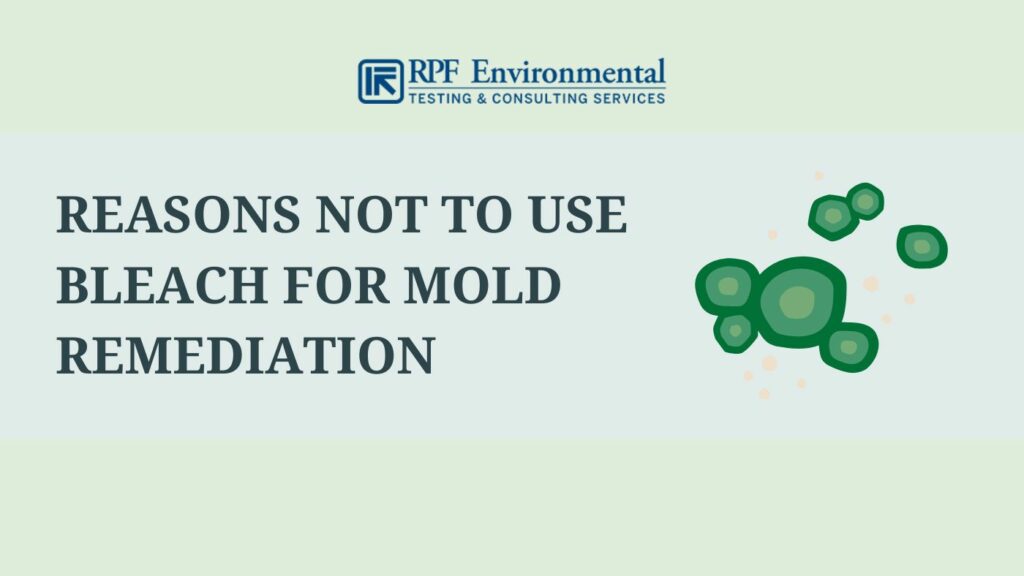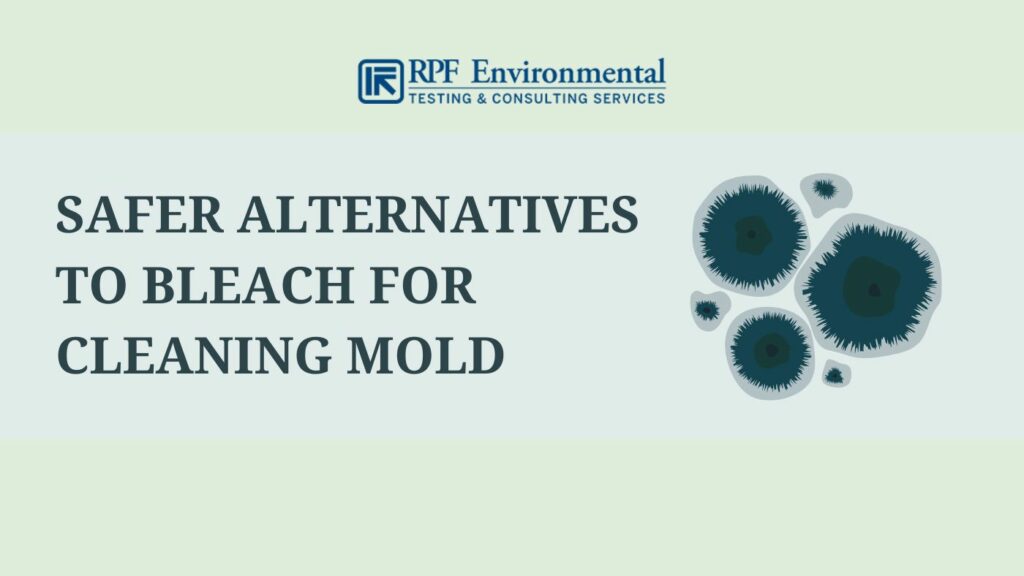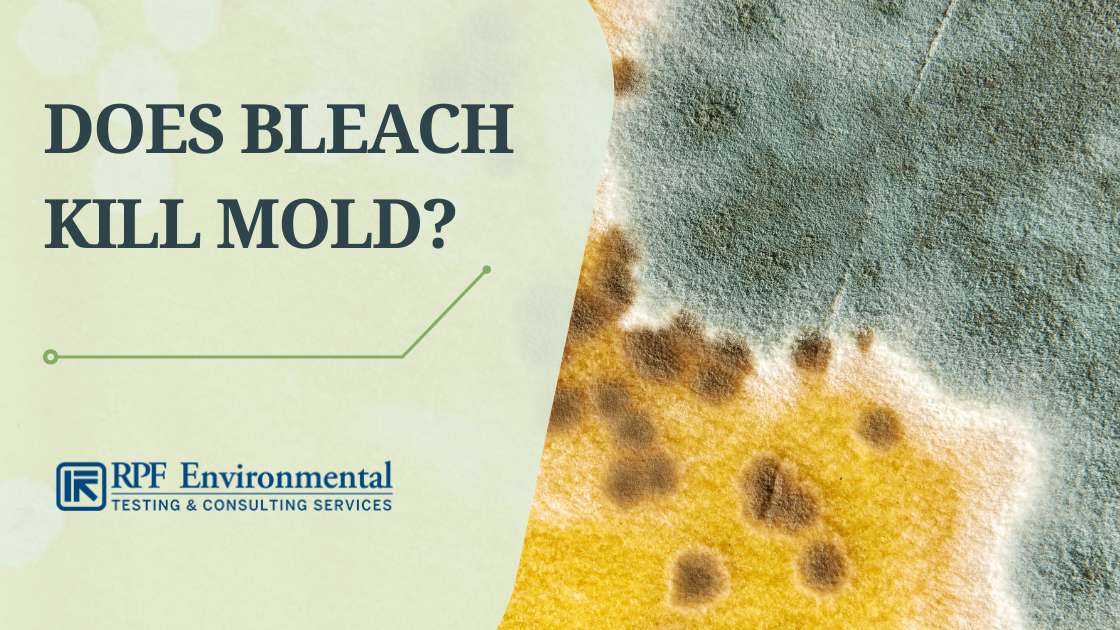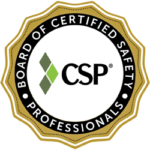What Does Bleach Do to Mold? Will It Really Kill Mold?
Bleach can kill moderate mold only when used under the right circumstances. Since bleach needs direct exposure for it to kill mold, it can be effective on surface molds on nonporous surfaces where you can easily wipe them off.
But with porous surfaces where mold can penetrate through and grow underneath, bleach won’t be effective. It will only change the mold’s color and the mold can grow back worse after a few days. In addition, bleach can’t kill airborne mold spores. The dead mold it leaves behind can even trigger allergic reactions when not removed.
Also read: Does mold die when it dries out?

RPF Environmental is a certified environmental consulting company that offers professional mold inspection services in New Hampshire, Maine, Massachusetts, and other areas across the country. Contact us now!
Why Not Use Bleach on Mold

Bleach can be good at removing surface molds, but there are reasons why you shouldn’t use it. In fact, OSHA and EPA don’t recommend using bleach as a routine practice for mold remediation.
If you are still not convinced why bleach isn’t a great alternative to eliminating mold, consider the following reasons:
1. Health Concerns Associated With Using Bleach
The most serious reason why you shouldn’t use bleach is its potential effects on you and your family’s health:
- Bleach can cause chemical burns and severe irritation to the skin.
- Mixing bleach with other chemicals releases toxic gasses that can cause chest pain, shortness of breath, nausea, coughing, pneumonia, watery eyes, and can irritate your eyes, nose, and throat.
- It produces dioxin, a highly toxic compound that causes cancer, in its gaseous state.
- Its fumes pollute the air and will make your family members with respiratory conditions suffer.
- It is also dangerous to your pets as it can cause lesions and chemical burns both internally and externally when swallowed.
2. Bleach Causes Structural Damage
Bleach is a corrosive chemical that is harmful especially to wooden structures as it will cause disintegration by breaking down the wood’s fibers. It can also corrode metal surfaces which will compromise the structural integrity of your home.
3. Bleach Can Worsen Mold Infestation
Since bleach doesn’t kill the roots underneath porous surfaces, it will only cause the mold to grow deeper and stronger as a reaction to the bleach. Also, bleach contains around 90% water. So once the chlorine evaporates and only the water is left, it will soak into the surface and feed the mold spores underneath it. This will make the infestation worse.
4. It Can’t Kill Mold Roots on Porous Surfaces
Mold has deep roots on porous surfaces that bleach can’t reach. Bleach may be able to eliminate the mold on the surface, but it doesn’t affect the membranes underneath which will cause the mold to return over time and worsen the condition.
Safer Alternatives to Bleach for Cleaning Mold

You can remove very moderate amounts of mold by using natural and non-toxic alternatives. Here are some alternatives:
1. Vinegar
Distilled white vinegar is among the most effective mold cleaners that can treat more than 80% of mold species. It works best when used undiluted.
2. Baking Soda
You can use fresh baking soda with vinegar or water to remove mold. Baking soda will be more effective if it bubbles vigorously after you put a drop of vinegar on it.
3. Hydrogen Peroxide
Hydrogen peroxide will bubble once you apply it to the mold which shows that it is working. Though it is safer compared to bleach, you still need to use rubber gloves and goggles when using it to avoid skin and eye irritation.
4. Lemon Juice
Lemon juice contains 5% acid which is effective in killing mold. You can use either a lemon juice concentrate or a freshly squeezed one as a daily cleaner to prevent mold growth in your kitchen and bathroom.
You might want to read more on our DIY mold remediation blog.
Where And When Can You Use Bleach to Remove Mold?
Bleach can be effective only when used under the right circumstances:
- Nonporous and hard surfaces: Tiles, glass, sinks, bathtubs, etc. (Don’t use on porous surfaces like wood, drywall, and carpeting.)
- Mild mold growths that are less than 10 sq. ft. (Call a professional for severe mold infestations)
Read more on where mold is found here.
Safety Reminders for Mold Remediation Using Bleach
The CDC advises against using bleach to kill mold without any protective gear. So if you decide to use bleach to eliminate mild mold growths on nonporous surfaces, take note of the following:
- Wear gloves, goggles, and an N-95 respirator
- Open doors and windows
- Don’t mix bleach with ammonia and other cleansers to avoid producing toxic fumes
- Have your HVAC system checked and cleaned before using it after the clean-up to avoid spreading mold throughout your house
One Last Tip: Mold Prevention
The key to avoiding mold infestation in the first place is controlling moisture. Here are a few tips given by EPA in their brief guide to mold in homes you can follow:
- Maintain indoor humidity below 60%
- Regularly clean roof gutters
- Dry wet surfaces quickly and reduce moisture sources
- Increase ventilation by using exhaust fans and opening windows
- Vent moisture-producing appliances to the outside
- Fix any water problems
- Dry items and areas that are damaged by water within 24-48 hours
FAQs
Chlorine bleach can kill mold on nonporous surfaces such as tiles, glass, and sinks but can make the mold worse on porous surfaces. The surface may appear clean, but the deep roots will keep on growing.
Vinegar is better at killing mold because it can work on both porous and nonporous surfaces. It also terminates molds at their roots so the mold won’t return and is also safer than bleach. You can even combine it with baking soda to make it more effective.
Bleach can’t penetrate through porous surfaces and eliminate the roots, so it won’t kill mold permanently.
Conclusion
Mold is a common problem in both residential and commercial establishments, especially in moisture-prone areas. It is recommended to work with a professional company to help identify and clean up mold.
Contact RPF Environmental’s experts for a mold inspection so we can help you make your home a safer space for your family! We also serve businesses and other industries in the New England area including New Hampshire, Maine, and Massachusetts.




